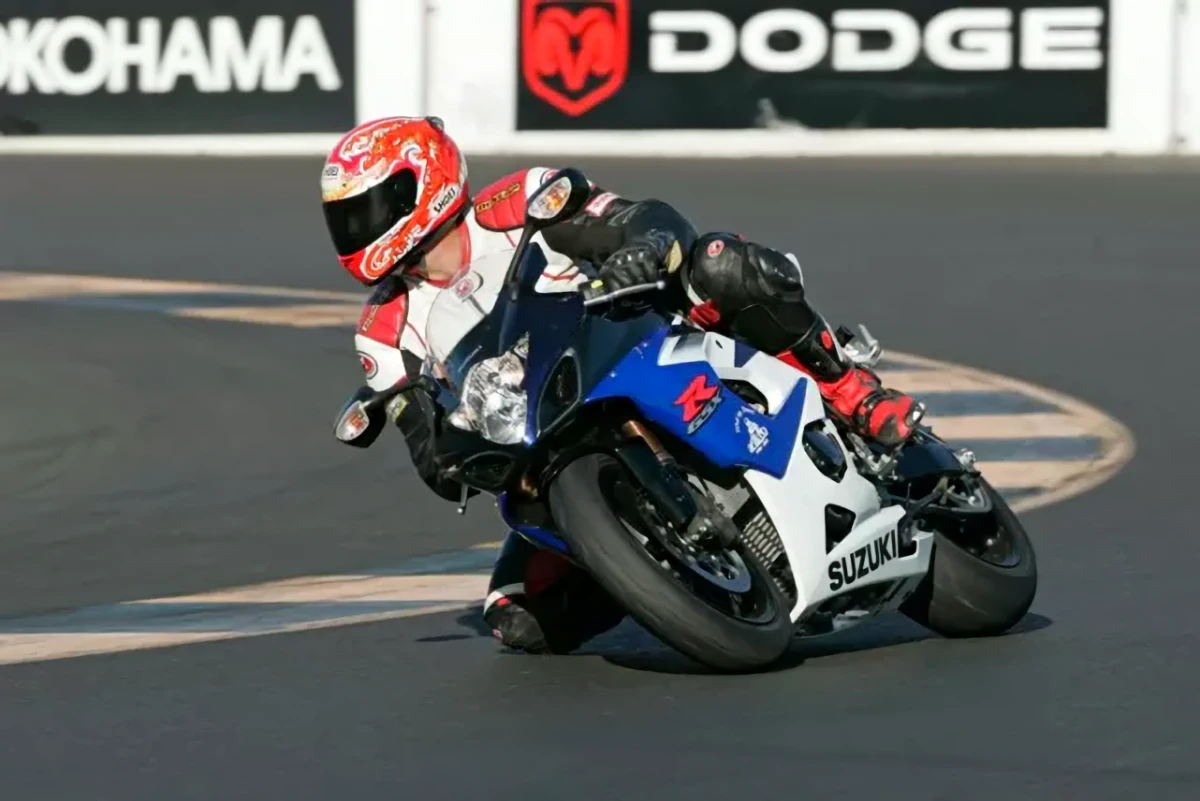“Weighting the pegs”
Doing so allows another huge tool to come into play. Shifting your weight to the inside of a turn changes the plane of the three spinning mechanical gyros of your motorcycle by giving input into the chassis towards the desired direction change. Which gyros are these?
Well first, let’s get a grasp of what I mean by a gyro. Everyone has taken the front wheel off their bicycle and spun it while holding it by the axle. Remember how weird if felt to change the direction of the spinning wheel? It fought with you. Try it again if you can’t remember. It is weird isn’t it? OK, so on a motorcycle there are three main gyros: the front wheel and tire, the rear wheel and tire and the engine’s spinning parts, the crankshaft, gears, all of those internal parts that create their own gyroscopic effect while running. It is why small engine bikes always handle better than larger engine bikes.
The modern 600 cc motorcycle is the most fun you can have on a modern bike.
They are a hoot. Those 1000 cc bikes are just tanks! Just ask anyone who has ridden them back to back. The small bikes always allow direction change faster and with less effort. How can we best change the direction plane of these gyros? By shifting the available weight through the chassis. What weight can be shifted? Our bodies. We move our weight by shifting ourselves across the seat, usually until our cheek is right over the seat edge (the center seam of our pants to the edge seam of the motorcycle seat, being PC).
How do you make this move? By leading with your hips. Why the hips? Besides the obvious mass, leading with our shoulders raises the center of gravity at the same time loading the bars as we lean across the tank. This is another one of those strange moments. If I asked you to touch your hip and then your shoulder, it should not be a problem.
The next time you try and start the inside weighting of the foot peg, make a conscious decision to start this with your hip. Watch what happens. Bet your shoulder leads the way. I cannot figure this one out, but it is the constant I have seen when teaching body steering over the years. Kind of makes everyone laugh until they get mad at themselves for not getting it done properly.
Changing the direction of the gyros in this manner does not adversely affect the available traction the tires are constantly searching for. This is the ideal method of direction change for a motorcycle. It is not the only method of change - and is not the only method that should be used - but it should be the primary tool we take out when negotiating turns. It leaves us with the most traction available and the smoothest approach to the task at hand.
Doing so allows another huge tool to come into play. Shifting your weight to the inside of a turn changes the plane of the three spinning mechanical gyros of your motorcycle by giving input into the chassis towards the desired direction change. Which gyros are these?
Well first, let’s get a grasp of what I mean by a gyro. Everyone has taken the front wheel off their bicycle and spun it while holding it by the axle. Remember how weird if felt to change the direction of the spinning wheel? It fought with you. Try it again if you can’t remember. It is weird isn’t it? OK, so on a motorcycle there are three main gyros: the front wheel and tire, the rear wheel and tire and the engine’s spinning parts, the crankshaft, gears, all of those internal parts that create their own gyroscopic effect while running. It is why small engine bikes always handle better than larger engine bikes.
The modern 600 cc motorcycle is the most fun you can have on a modern bike.
They are a hoot. Those 1000 cc bikes are just tanks! Just ask anyone who has ridden them back to back. The small bikes always allow direction change faster and with less effort. How can we best change the direction plane of these gyros? By shifting the available weight through the chassis. What weight can be shifted? Our bodies. We move our weight by shifting ourselves across the seat, usually until our cheek is right over the seat edge (the center seam of our pants to the edge seam of the motorcycle seat, being PC).
How do you make this move? By leading with your hips. Why the hips? Besides the obvious mass, leading with our shoulders raises the center of gravity at the same time loading the bars as we lean across the tank. This is another one of those strange moments. If I asked you to touch your hip and then your shoulder, it should not be a problem.
The next time you try and start the inside weighting of the foot peg, make a conscious decision to start this with your hip. Watch what happens. Bet your shoulder leads the way. I cannot figure this one out, but it is the constant I have seen when teaching body steering over the years. Kind of makes everyone laugh until they get mad at themselves for not getting it done properly.
Changing the direction of the gyros in this manner does not adversely affect the available traction the tires are constantly searching for. This is the ideal method of direction change for a motorcycle. It is not the only method of change - and is not the only method that should be used - but it should be the primary tool we take out when negotiating turns. It leaves us with the most traction available and the smoothest approach to the task at hand.

